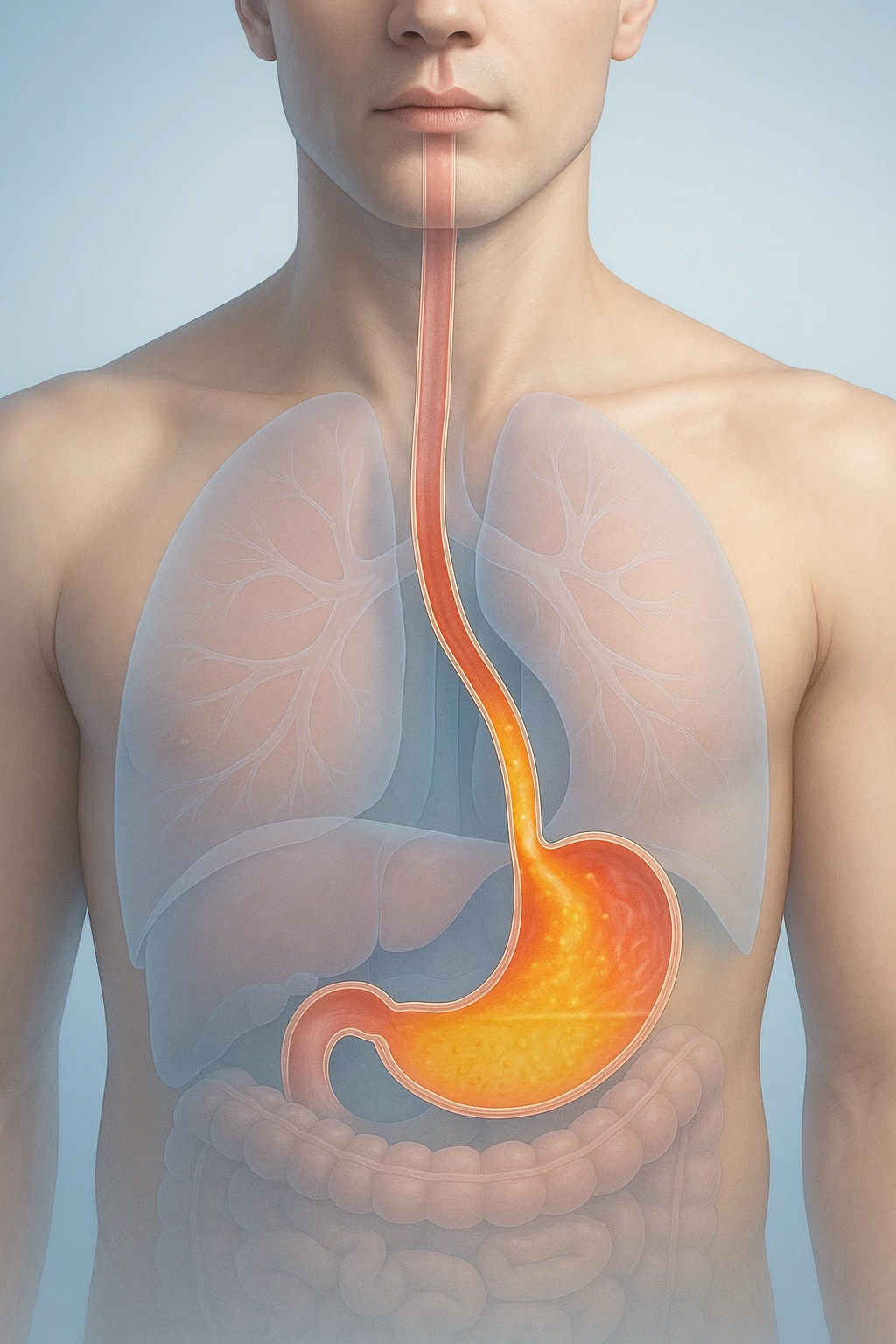Constipation in Adults: Causes, Diagnosis, and Treatment
Constipation: Epidemiology, Definition, and Diagnostic Classification
Epidemiology and Clinical Burden
Constipation is among the most frequent gastrointestinal complaints encountered in clinical practice. It affects approximately 14% of adults worldwide, with prevalence increasing with age and slightly higher rates observed in women. Although often considered benign, chronic constipation significantly affects daily functioning, emotional well-being, and productivity. Patients frequently experience discomfort, bloating, and a reduced sense of health-related quality of life. Beyond the personal burden, constipation contributes to substantial healthcare costs through outpatient visits, diagnostic evaluations, and medication use.
- Estimated global prevalence: approximately 14% of adults.
- Higher prevalence in older adults and women.
- Linked to reduced quality of life and higher healthcare utilization.
The chronic nature of the disorder often leads to repeated consultations and polypharmacy, emphasizing the importance of accurate diagnosis and personalized management. Recognizing constipation as a condition with measurable clinical and economic implications supports early identification and preventive care across healthcare settings.
Functional Constipation vs IBS-C
Chronic constipation encompasses two primary diagnostic categories: functional constipation and constipation-predominant irritable bowel syndrome (IBS-C). While both share symptoms such as infrequent or difficult bowel movements, the defining distinction is the presence of recurrent abdominal pain. In IBS-C, abdominal pain or discomfort is a core feature, typically relieved by defecation or associated with changes in stool form or frequency. In contrast, functional constipation presents mainly with bowel movement difficulty and a sense of incomplete evacuation without recurrent abdominal pain.
| Feature | Functional Constipation (FC) | IBS-C |
|---|---|---|
| Main symptom | Difficult or infrequent bowel movements | Recurrent abdominal pain with bowel changes |
| Abdominal pain | Absent or minimal | Prominent and recurrent |
| Relation to defecation | May not relieve symptoms | Pain often relieved by defecation |
| Primary focus of management | Improve bowel frequency and stool consistency | Address both pain and bowel habit alterations |
Understanding this distinction is essential for guiding clinical evaluation, patient education, and treatment selection. Clinicians should assess symptom patterns carefully to determine whether abdominal pain is a driving component and apply the correct diagnostic category.
Diagnostic Criteria and Frameworks
To ensure diagnostic consistency, constipation is defined through structured clinical frameworks such as the Rome IV criteria. These criteria specify the duration, frequency, and characteristics of symptoms required for diagnosis, typically including fewer than three spontaneous bowel movements per week, straining, hard or lumpy stools, or a sensation of blockage during defecation. Symptoms must be present for at least three months to meet chronicity requirements.
- Fewer than three spontaneous bowel movements per week
- Frequent straining during defecation
- Hard or lumpy stools
- Sensation of incomplete evacuation or blockage
- Symptoms persisting for at least three months
Adhering to these frameworks helps clinicians differentiate functional from secondary constipation and ensures consistent communication across clinical settings. They promote systematic, evidence-based assessment aligned with individualized care.
Constipation Etiology, Risk Factors, and Clinical Evaluation
Primary and Secondary Etiologies
Constipation arises from a wide range of causes classified as primary (functional) or secondary. Primary constipation refers to intrinsic bowel dysfunction, such as slow-transit constipation caused by impaired colonic motility, or defecatory disorders involving pelvic floor dyssynergia or outlet obstruction. These mechanisms usually reflect neuromuscular or coordination abnormalities rather than structural disease.
Secondary constipation occurs when an underlying factor disrupts normal bowel function. Common causes include:
- Medications: opioids, anticholinergics, calcium channel blockers, and iron supplements
- Metabolic and endocrine disorders: hypothyroidism, diabetes, and hypercalcemia
- Structural causes: colorectal strictures, masses, or pelvic organ prolapse
Identifying and addressing these secondary factors is essential before diagnosing functional constipation.
Clinical Evaluation and Alarm Features
Assessment begins with a detailed medical history and physical examination. Clinicians should evaluate symptom duration, stool frequency, consistency, diet, hydration, and medication use. Medication review is especially important as many drugs are constipating.
Key alarm features that warrant further investigation include:
- Rectal bleeding
- Unexplained weight loss
- Anemia
- Family history of colorectal cancer
Physical examination should include abdominal assessment and a digital rectal exam to evaluate sphincter tone, pelvic floor function, and detect masses or impaction. This step provides immediate diagnostic clues and guides additional testing. A methodical approach helps differentiate functional from secondary constipation and avoids missing serious pathology.
Diagnostic Modalities
When standard evaluation and interventions do not clarify the cause, physiologic testing may be indicated. Common diagnostic tools include:
- Anorectal manometry and balloon expulsion testing: Identify defecatory disorders such as dyssynergic defecation.
- Colonic transit testing: Used to determine whether slow-transit constipation is present when defecatory dysfunction is excluded.
These tests confirm outlet obstruction and guide targeted therapies such as biofeedback. Incorporating them within a stepwise evaluation framework ensures comprehensive assessment of chronic constipation causes.
Lifestyle and Nonpharmacologic Management of Constipation
Dietary Fiber and Hydration
Optimizing dietary fiber intake and maintaining adequate hydration are fundamental in constipation management. Fiber increases stool bulk and promotes colonic transit by enhancing water retention in the stool. Most adults benefit from gradually increasing fiber intake from sources such as fruits, vegetables, whole grains, and legumes. Soluble fibers, including psyllium, are typically better tolerated and more effective than insoluble forms. Increased fiber should always be accompanied by sufficient fluid intake to prevent bloating or worsening symptoms.
- Gradually increase fiber intake from natural foods
- Prefer soluble fiber (e.g., psyllium) for better tolerance
- Maintain adequate fluid intake alongside fiber
- Encourage consistent hydration throughout the day
Proper hydration softens stool and supports regular bowel movements. Although fluid needs vary, consistent water intake remains essential. Combined, these measures form the basis of first-line therapy for mild or chronic constipation.
Physical Activity and Behavioral Modifications
Regular physical activity enhances bowel motility and overall gastrointestinal function. Even moderate exercise, such as walking, can stimulate intestinal contractions and reduce symptom persistence. Behavioral modifications also support long-term symptom control. Establishing consistent toileting habits-especially after meals when colonic motility increases-can improve regularity.
- Engage in daily moderate exercise, such as walking
- Adopt a consistent toileting routine after meals
- Use proper defecation posture (elevate feet if needed)
Appropriate toileting posture reduces anorectal angle strain and facilitates stool passage. These straightforward interventions can significantly improve outcomes and reduce reliance on pharmacologic therapy.
Patient Education and Preventive Counseling
Patient education is key to sustaining lifestyle improvements and preventing recurrence. Clinicians should explain the connection between diet, activity, and bowel function, emphasizing that constipation is multifactorial and often improves through cumulative behavioral changes. Counseling should promote gradual, consistent adjustments tailored to each patient.
Effective lifestyle management not only relieves symptoms but also improves quality of life and decreases recurrent healthcare visits. Long-term adherence reduces the personal and economic burden of chronic constipation through self-directed preventive care.
Evidence-Based Pharmacologic and Procedural Treatments for Constipation
Stepwise Pharmacologic Management
The pharmacologic treatment of chronic constipation follows a stepwise approach balancing efficacy, safety, and patient tolerance. First-line therapy generally involves osmotic laxatives, which soften stool and increase colonic water content to facilitate passage. Polyethylene glycol and lactulose are common and effective agents recommended when dietary and lifestyle measures are insufficient.
- Osmotic laxatives: Polyethylene glycol, lactulose – first-line options
- Stimulant laxatives: Bisacodyl, senna – for short-term or intermittent use
- Secretagogues: Lubiprostone, linaclotide – promote chloride and water secretion
- Bile acid transporter inhibitors: Considered for refractory cases to enhance colonic motility
When osmotic laxatives yield partial benefit, stimulant laxatives can augment bowel motility. For persistent symptoms, secretagogues or bile acid transporter inhibitors may be introduced to enhance intestinal secretion and motility, improving stool frequency and consistency.
Defecatory Disorders and Biofeedback
When anorectal testing confirms defecatory dysfunction, biofeedback therapy serves as first-line treatment. This noninvasive behavioral approach retrains pelvic floor and anal sphincter muscles for coordinated defecation using real-time feedback from manometric or electromyographic monitoring.
Biofeedback achieves high success rates in dyssynergic defecation, often outperforming laxatives. Although it requires active participation and multiple sessions, its benefits are durable, especially when supported by home-based exercises. Identifying defecatory disorders accurately ensures targeted and effective intervention.
Refractory Constipation and Surgical Interventions
For patients unresponsive to optimal medical and behavioral therapies, advanced interventions may be needed. Refractory constipation warrants reassessment for motility disorders such as slow-transit constipation. Colonic transit studies can confirm diagnosis and guide care escalation.
- Combination pharmacologic regimens: Secretagogues plus stimulant laxatives before procedural options
- Surgical interventions: Subtotal colectomy with ileorectal anastomosis for confirmed slow-transit constipation
- Emerging approaches: Neuromodulation and experimental therapies under study
A multidisciplinary approach-including gastroenterology, colorectal surgery, and pelvic floor rehabilitation-ensures individualized, evidence-based management of complex cases.
Long-Term Management, Prevention, and Outcomes in Constipation
Monitoring and Recurrence Prevention
Long-term management of constipation requires continuous monitoring of symptoms and reinforcement of healthy bowel habits. Regular follow-up enables clinicians to evaluate treatment adherence, assess bowel frequency, and adjust interventions as needed. Preventive measures-such as maintaining adequate dietary fiber intake, ensuring consistent hydration, and engaging in physical activity-remain the cornerstone of sustained management. These foundational lifestyle habits help preserve bowel motility and reduce the likelihood of symptom recurrence after initial improvement.
- Maintain consistent dietary fiber intake from natural food sources.
- Ensure adequate daily hydration.
- Include regular physical activity in daily routines.
- Practice proper toileting posture and avoid excessive straining.
Ongoing education about toileting posture, timing, and avoidance of unnecessary straining supports durable symptom control. By incorporating these behavioral practices into daily routines, patients can sustain bowel regularity and minimize long-term reliance on pharmacologic agents.
Addressing Multimorbidity and Polypharmacy
Constipation commonly affects individuals with multiple chronic diseases or those taking medications that reduce bowel motility. Polypharmacy-particularly with opioids, anticholinergics, or calcium channel blockers-necessitates routine medication review to identify and mitigate contributing factors. Collaboration among healthcare providers is essential to safely adjust regimens without compromising control of comorbid conditions. Attention to medication side effects, hydration status, and physical mobility helps prevent worsening symptoms, especially in older or medically complex patients.
| Category | Examples | Management Focus |
|---|---|---|
| Medications | Opioids, anticholinergics, calcium channel blockers | Regular review and substitution when appropriate |
| Chronic Conditions | Diabetes, hypothyroidism, neurologic disorders | Integrate bowel care into multimorbidity management |
| Lifestyle Factors | Reduced mobility, inadequate hydration | Encourage gradual physical activity and adequate fluid intake |
Integrating constipation management within overall chronic disease care ensures early identification of contributing factors and reduces the need for repeated interventions. A coordinated, multidisciplinary strategy improves both gastrointestinal outcomes and overall patient well-being.
Improving Long-Term Quality of Life
Chronic constipation substantially affects daily functioning, productivity, and emotional health. Persistent symptoms may restrict social engagement and cause anxiety or discomfort, highlighting the need for sustained symptom control. Improvements in stool consistency and bowel frequency are directly linked to better quality of life and reduced healthcare utilization.
Encouraging adherence to preventive strategies-especially lifestyle modifications-yields measurable benefits for individuals and healthcare systems. Supported by consistent follow-up and patient engagement, these measures reduce the personal and economic burden of chronic constipation and promote lasting improvements in health and well-being.
Frequently Asked Questions About Constipation
- How can I tell if I’m experiencing chronic constipation?
- Chronic constipation is defined by infrequent or difficult bowel movements lasting at least three months. You may notice straining, hard stools, or a sensation of incomplete evacuation.
- Is constipation more common in older adults?
- Yes, constipation becomes more frequent with age, partly due to slower bowel motility, lower physical activity, and the use of certain medications.
- Which medical conditions or drugs can make constipation worse?
- Medications such as opioids, anticholinergics, and calcium channel blockers can slow bowel function. Conditions like hypothyroidism or diabetes may also contribute.
- What symptoms should prompt medical evaluation?
- Seek medical advice if constipation is accompanied by rectal bleeding, weight loss, anemia, or new-onset symptoms in older age, as these may indicate an underlying disorder.
- Can lifestyle changes really relieve constipation?
- Yes, regular exercise, adequate hydration, and a high-fiber diet often improve bowel regularity and may reduce the need for medication.
- Are fiber supplements as effective as dietary sources?
- Soluble fiber supplements, such as psyllium, can help when dietary intake is insufficient. However, natural sources like fruits and whole grains are generally preferred.
- When do laxatives become necessary for constipation?
- Laxatives are typically used when lifestyle measures fail. Osmotic laxatives are considered first-line, while stimulant or secretagogue agents are reserved for persistent symptoms.
- How does biofeedback therapy work for constipation?
- Biofeedback retrains pelvic floor muscles to improve coordination during defecation. It’s especially effective for defecatory disorders confirmed through diagnostic testing.
- What happens if constipation doesn’t improve with standard treatment?
- Persistent or refractory constipation may require specialized tests to identify slow-transit disorders or defecatory dysfunction, and in rare cases, surgical intervention.
- Does constipation affect emotional well-being?
- Chronic constipation can impact mood, comfort, and daily functioning. Managing symptoms effectively often improves overall quality of life and confidence.













